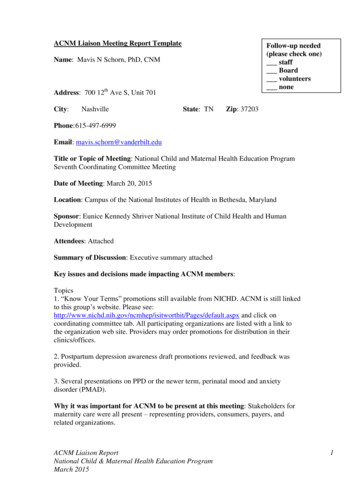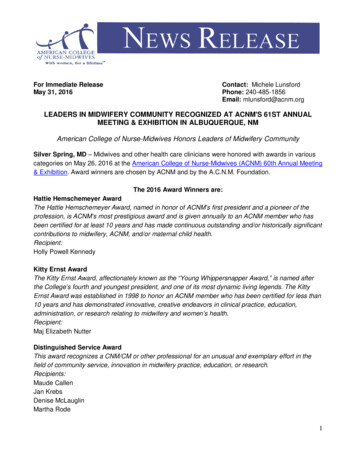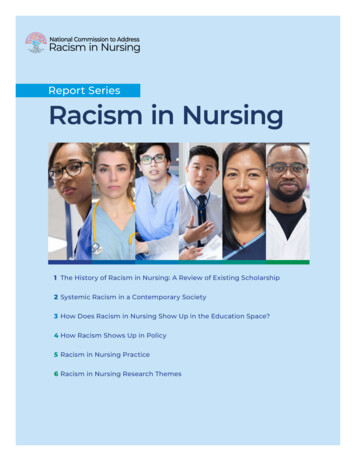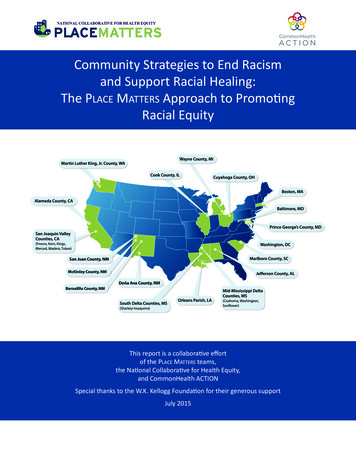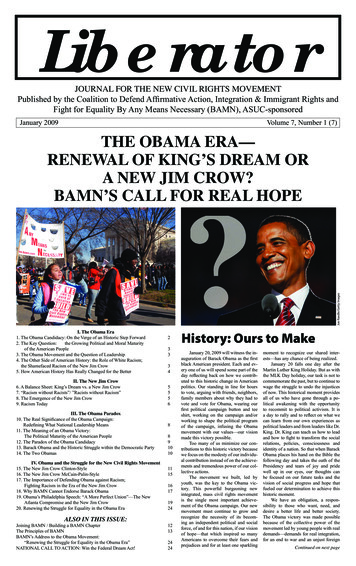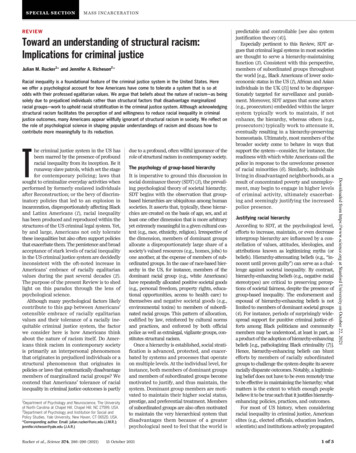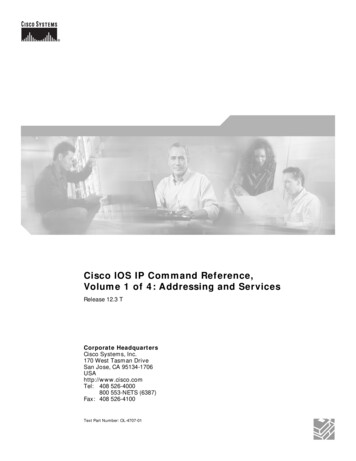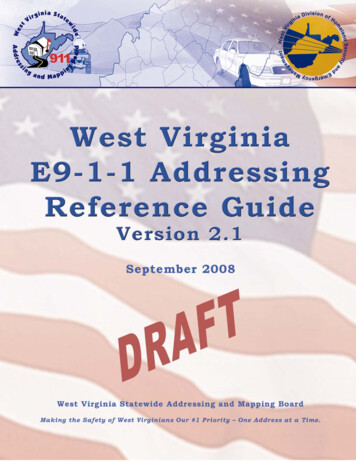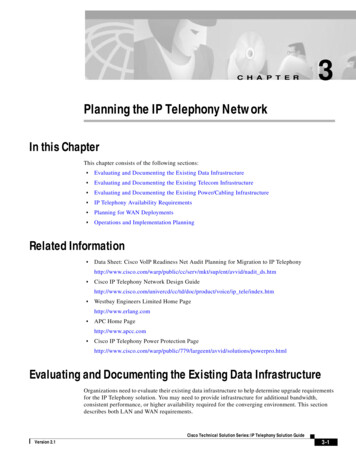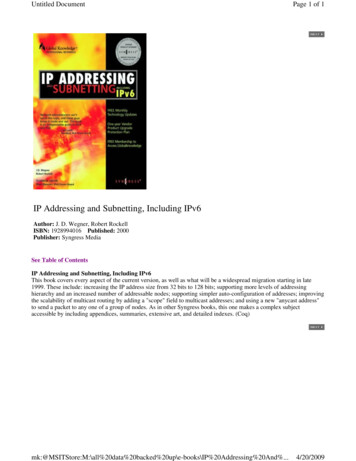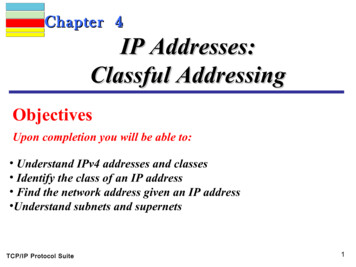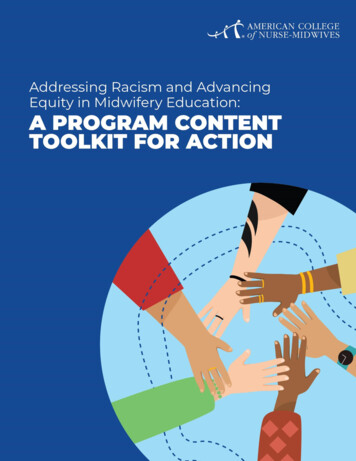
Transcription
ACNMAddressing Racism and Advancing Equity in Midwifery Education:A Program Content Toolkit for Action1
Program Content Subgroup MembersNancy MacMorris-Adix, CNM, MN,FACNMCo-ChairRetiredSalem, OREmily Stallings, CNM, MS, MIDCo-ChairNew-Graduates RepresentativeMidwife & InstructorWest Virginia UniversityMorgantown, WVHeather Bradford, PhD(c), CNM, FACNMSecretary, Vice Chair, ACNM FellowsAssistant Program DirectorWHNP and NM/WHNP ProgramsGeorgetown UniversityWashington, DCSeattle, WABridget Howard, CNM, MSNACNM Board of Directors LiaisonACNM BOD SecretaryManager, Advanced Practice NurseProviders - Women’s HealthUniversity of Pennsylvania Health SystemPhiladelphia, PACarol Bues, DNP, LM, CNM, WHNP,FACNMSankalpa MidwiferyCUNY Lehman CollegeNew York, NYACNMEva Fried, DNP, CNM, WHNPACME RepresentativeChair, Publications CommitteeCommissioner, ACMENurse-Midwifery Program DirectorUniversity of CincinnatiCincinnati, OHKimberly Garcia, DNP, CNM, WHNP,MSN, FACNMMOCC representativeAssociate ProfessorDirector of Midwifery EducationUniversity of UtahSalt Lake City, UTWendy Gordon, DM, MPH, CPM, LMDepartment Chair & Associate ProfessorBastyr UniversitySeattle, WAJennifer Johnson, CNM, MSAssistant ProfessorThomas Jefferson UniversityStaff MidwifeJefferson Health - Abington HospitalClinical Operations ConsultantPrimary Maternity CarePhiladelphia, PATamika Julien, DNP, CNM, WHNP-BC,CLCLecturer, Yale School of NursingFaculty CNM, Yale Midwifery FacultyPracticeNew Haven, CTAddressing Racism and Advancing Equity in Midwifery Education:A Program Content Toolkit for Action2
Laura Manns-James, PhD, CNM,WHNP-BC, CNE, FACNMAssociate ProfessorFrontier Nursing UniversityVersailles, KYCatherine Palmer, CNM, IBCLC, RNStudent and New Graduates RepresentativeStaff CNMAtlanta, GAAllyson Royer-Esquibel, MSN,CFNP, CNMAPC Residency Program ManagerPrimary Care ProviderPresbyterian Healthcare ServicesAlbuquerque, NMACNMAddressing Racism and Advancing Equity in Midwifery Education:A Program Content Toolkit for Action3
Table of ContentsIntroduction . 5Introduction to Racism in the Program Content of Midwifery Education . 5Statement on Racism in the Teaching of Midwifery History . 6About the Toolkit . 7Purpose of the Toolkit . 7Limitations of the Toolkit . 7Recommendations to the ACNM Board of Directors . 9Characteristics of White Supremacy Culture . 10Resources and Tools for Faculty . 13Understanding the Impact of Racism in Midwifery Education on MidwiferyStudents of Color . 13Tools for Self-Reflection. 13Introduction. 13Recommendations . 14Tools for Assessing Program Content for Racism . 15Curriculum Assessment. 15Text Evaluation . 15Tools for Building Antiracist Curricula . 16Assignment Suggestion: Script Writing . 16Introduction to Resources, Tools, and Antiracism Glossary . 20Appendix A: From Listening to Action: Understanding the Impact of RacismWithin Midwifery Education on Midwifery Students of Color . 21Appendix B: White Privilege: Unpacking the Invisible Knapsack by PeggyMcintosh . 24Appendix C: Wells’ Self-Assessment Tool: Anti-Racism3 . 29Appendix D: Curriculum Assessment Tool. 44Appendix E: Midwifery Antiracism Text Evaluation Tool . 50Appendix F: Midwifery Textbooks Through an Antiracism Lens:Evaluation Summaries . 54Appendix G: Scripting Assignment Handout . 64Appendix H: Scripting Examples . 66Appendix I: Resource List for Faculty to Engage in Antiracism . 69Appendix J: Antiracism Glossary . 74Appendix K: References . 98ACNMAddressing Racism and Advancing Equity in Midwifery Education:A Program Content Toolkit for Action4
IntroductionThe racial justice movement which coalesced and swept across the United Statesfollowing the murder of George Floyd, Jr on May 25, 2020, has forced manyorganizations to begin to confront racism within their own structures and history. Amongthose organizations, the American College of Nurse-Midwives (ACNM) began to heedthe decades-long call for a thorough examination of racism within midwifery education,practice, and the organization itself. As part of that process, ACNM formed the Racismin Midwifery Education Task Force. This Task Force was divided into subgroupsdesigned to focus on elements of midwifery education. The authors of this toolkitvolunteered to become the Program Content Subgroup (PCS), which was tasked toexplore how racism is manifested in and rooted within midwifery education programcontent and to recommend ways to eradicate it and build antiracist curricula.Efforts to address racism within ACNM and midwifery in the United States are not new.There is a powerful lineage of midwives of color who individually and collectively haveworked to create space within ACNM, prompt essential change within the organization,and build a just and equitable organization and greater midwifery culture. Into the Lightof Day: Reflections on the History of Midwives of Color Within the American College ofNurse-Midwives1 by Linda Janet Holmes is the authoritative text on this work, and thePCS recommends that all faculty read it and add it to their curriculum.Introduction to Racism in the Program Content of Midwifery EducationRacism is pervasive within midwifery education at the individual, institutional, andstructural levels. The PCS' work as a subgroup was to focus on places where racism isevident in midwifery education program content. Racist ideology is present in the textswe read and recommend, the presentations we give, and the way we conceptualize andtalk about midwifery in the United States.One of the most egregious manifestations of racism in midwifery education is the waymidwifery history is taught. In addition, the PCS sees biological racism perpetuatedthrough our texts, such as when genetic ancestry is equated to race and an individual’srace is considered a risk factor for pathology. White bodies are treated as the norm inthe images we choose. White supremacy culture is evident in how we design programsand measure success. This Toolkit is intended to help midwifery educators reflect ontheir own racism, recognize how racism is present in midwifery education, and offertools to address racism and build antiracist programs.ACNMAddressing Racism and Advancing Equity in Midwifery Education:A Program Content Toolkit for Action5
Statement on Racism in the Teaching of Midwifery HistoryThe PCS of the Racism in Midwifery Education Task Force stands with the Midwives ofColor Committee and student members of ACNM in strongly encouraging all midwiferyeducation programs to include in their content a robust history of midwifery practice inthe United States, which should include the histories of midwives of color andIndigenous midwives. The systemic erasure of these histories has contributed to thedisenfranchisement of midwives of color and has perpetuated the racial disparities seenin maternal and infant health and care today. Prioritizing the history of white midwives,while ignoring the stories of midwives of color, is racist and should be stopped.Midwifery education programs have a duty to ensure that students understand the manyways midwifery has been practiced throughout the United States, and how theprofessionalization of the vocation has harmed communities of color, including thepeople we serve. These understandings are vital to students’ conception of themselvesas midwives and to their aptitude as future health care providers.Racist ideology in midwifery can be passed down through educational institutions, butso, too, can an orientation of antiracism. Midwifery education programs have anopportunity to empower their students to be antiracist leaders through a robust andreflective examination of our collective history as midwives.ACNMAddressing Racism and Advancing Equity in Midwifery Education:A Program Content Toolkit for Action6
About the ToolkitPurpose of the ToolkitThe purpose of the Toolkit is to provide faculty with resources for ensuring that theirprograms are addressing the historical racism in American midwifery and preparingfuture midwives to be aware of racism and bias in themselves, in institutions, and in thehealth care system. The Toolkit offers some insight into the impact of racism withinmidwifery education on midwifery students of color. It provides self-assessmentresources for faculty to learn and grow regarding their own implicit biases and racistideas. This foundational work is essential and ongoing. It provides a tool to evaluate thecontent of midwifery courses through a lens of antiracism and bias reduction. The last 2components are a sample assignment for students and a tool for evaluating textbooks,respectively. Both are presented along with examples as to how these could be used ineducation.Limitations of the ToolkitThere are many limitations to the Toolkit, but the members of the PCS view it as astarting point.First, the Toolkit is not the panacea for all manifestations of racism within midwiferyeducation. Simply using the Toolkit to improve program content will not eradicate racismwithin midwifery education. Use of the Toolkit is not an alternative to increasing diversityand representation among midwifery faculty and program directors. This documentshould be viewed as one tool in the work of addressing racism within midwiferyeducation.Second, the Toolkit is a product of its time. It is not a tool that will forever retain itsrelevance in its current form. The PCS hopes that in engaging in the important endeavorof confronting racism, the most pressing challenges of today will improve. They envisioniterative editions of the Toolkit or the creation of a new one wholesale at some juncturefor it to be essential and relevant.Third, the Toolkit is a product of those who created it. The members of the PCS largelyreflect the current membership of ACNM and the demographics of practicing midwives.Most of the subgroup members are racialized as white in a white supremacist world.The Toolkit would not be possible without the invaluable contributions, wisdom, andvisionary leadership of the PCS members of color.ACNMAddressing Racism and Advancing Equity in Midwifery Education:A Program Content Toolkit for Action7
Fourth, this Toolkit is directed toward midwifery faculty—a majority-white group—manyof whom may just be beginning their antiracism work. Although the PCS membersbelieve in the need for racial healing and desire to focus on resilience, they feel that theessential first step is to stop harm that is occurring. Members of the PCS believe that animportant next step will be to focus on the importance of healing and resilience.Fifth, the PCS recognizes that many midwifery education programs are housed withincolleges of nursing. Some of the most egregious examples of racism in program contentare seen in pre-RN licensure courses. In addition, midwifery programs likely haveconstraints placed on them by the larger college to which they belong. To this, the PCScannot speak in detail, given that each situation is unique. The subgroup hopes thatfaculty and program directors in such institutions see themselves as possible catalystsfor broader change.Sixth, most members of the subgroup are nurse-midwives. The PCS believes that theprinciples and tools referenced herein are broadly applicable to all midwiferyeducational programs.Finally, the creation of a toolkit does not ensure its use. The Racism in MidwiferyEducation Task Force was created to make recommendations to the ACNM Board ofDirectors (BOD). Some recommendations, though, fall outside ACNM’s jurisdiction.True change will require the Accreditation Commission for Midwifery Education (ACME)and American Midwifery Certification Board (AMCB) to modify what is expected ofprograms and those prepared to begin practice. To that end, the PCS has collaboratedwith other subgroups in the Task Force to create a list of recommendations to theACNM BOD, who may have leverage to prompt change (see below).ACNMAddressing Racism and Advancing Equity in Midwifery Education:A Program Content Toolkit for Action8
Recommendations to the ACNM Board of DirectorsIn addition to creating the Toolkit, the PCS created the following list ofrecommendations for the ACNM BOD:A. ACNM should advocate for ACME credentialing/recredentialing criteria forprograms that they incorporate a more complete, accurate, antiracist, non-whitesupremacist history of midwifery into their curricula;B. ACNM should acknowledge that current and past core midwifery textbookscontain racist content, and ACNM should advocate for antiracist textbookrevisions;C. ACNM should advocate that antiracist deliverables developed by the Task Forcebe part of the educational program credentialing/recredentialing process ofACME;D. Consistent with ACNM’s Strategic Plan, the BOD should continue the importantwork of this Task Force with a long-term focus on not only addressing harm butalso on fostering racial healing and a positive racial climate, as well asacknowledging and bolstering resilience;E. ACNM should create a permanent office and full-time position for a Diversity,Equity, Inclusion, and Belonging (DEIB) professional to coordinate antiracisminitiatives within the College; andF. ACNM should develop a plan to distribute and implement this Toolkit. This planshould include a study of the impact of Toolkit use within midwifery programsbefore its use is made mandatory.ACNMAddressing Racism and Advancing Equity in Midwifery Education:A Program Content Toolkit for Action9
Characteristics of White Supremacy CultureOne of the greatest challenges to confronting white supremacy is the way in which ithas historically masked its own existence to white people. Those who grow up with theprivilege of being white live in a world where everything reflects their own culture backat them. Whiteness is treated as the default, which leads to the thinking that otherracial/ethnic identities are inferior. Racism is present in our curricula and programs notsolely in the images we use, but also in what is included in the history of midwifery, andin equating race with genetic ancestry. It is present in how we structure our programs,what is expected of both students and faculty, and in what has been left out.In 2001, Kenneth Jones and Tema Okun wrote the essential Dismantling Racism: AWorkbook for Social Change Groups,1 which clearly outlined characteristics of whitesupremacy culture. This work was based on a similar article written by Okun alone in1999. Okun also wrote an article in 2021 titled, “White supremacy culture - still here,”2which is an update to her original work. Below is the list of characteristics Okunincluded, along with examples of how those characteristics might manifest in midwiferyeducation. Consider which of these might be manifest in your program.FearAre students who do not fit the stereotypical midwifery mold appreciated or feared forupsetting the status quo?PerfectionismAre we focused more on right answers than on learning?Sense of urgencyIs it really essential that late work receives no credit? Are the program's policies helpfulin learning?DefensivenessIs any criticism of the current structure met with “this is how we’ve always done it”thinking?DenialIs your program admitting to and addressing its white supremacy?QualifiedAre midwives (a predominantly white group in the United States) portrayed as imbuedwith the duty and ability to fix things and save (minoritized) others?ACNMAddressing Racism and Advancing Equity in Midwifery Education:A Program Content Toolkit for Action10
Quantity over qualityWhen there is a conflict between covering content and learner processes, which onewins?Worship of the written wordAre soft skills undervalued? What about clinical skills? Is lived experience dismissed?Only one right wayBeyond questions of science and safety, are alternative approaches and experiencesvalued?PaternalismIs decision-making shared? Is the decision-making process clear to those who do nothave power?Either/or thinking and the binary constructIs everything simply right or wrong? Are complex things overly simplified?Power hoardingIs there a desire to share decision-making? Are suggestions for change seen as threatsto authority?Fear of open conflictIs there investment in side-lining conflict? Are students who raise concerns seen asproblematic?IndividualismDo students feel a part of a community? Is there peer accountability or only hierarchicalaccountability?‘I’m the only one’Is the most vocal person the leader? Is there a sense that there is a “right” way to dothings and that only one person can complete the task in the right way?Progress equals “bigger,” “more”Is the best metric of your program’s success the number of students who enroll?ObjectivityACNMAddressing Racism and Advancing Equity in Midwifery Education:A Program Content Toolkit for Action11
Do course goals assume linear thinking? Is emotion treated as though it should not beinvolved in decision-making?Right to comfortDo those with power feel entitled to protection from emotional or psychologicaldiscomfort?We understand that there are constraints to program and course design and onrequirements placed on programs to facilitate students hitting certain milestones. Thepurpose of this list is to highlight areas that may be ripe for ongoing work. Awareness isthe first step. Given that most midwifery educators are white, these characteristics mayfeel as commonplace and as inevitable as gravity. They are not.ACNMAddressing Racism and Advancing Equity in Midwifery Education:A Program Content Toolkit for Action12
Resources and Tools for FacultyUnderstanding the Impact of Racism in Midwifery Education on MidwiferyStudents of ColorAppendix A is a summary (written by Emily Stallings) of a presentation given at the2020 ACNM Inclusion Conference: Dare to Think Different. The presentation was acompilation of qualitative analyses of the data regarding the impact that racism withinthe current midwifery education programs was having on students of color.Tools for Self-Reflection(Jennifer Johnson, Tamika Julien, Catherine Palmer)IntroductionTo build and deliver antiracist midwifery curricula, midwifery educators must createpractices of critical self-reflection and bolster their resilience for the ongoing work ofreflexivity and self-accountability. The work of being antiracist is a continually evolvingjourney. Unlike the proficiency gained by completing a competencies checklist,midwifery educators cannot become proficient at antiracism. Rather, it is a process ofcontinued growth, knowledge, and commitment to action that requires self-knowledgeand self-critique.To implement the recommendations offered throughout the Toolkit, the PCS believesthat midwifery educators must continually check in with their own understandings ofracism, whiteness, white supremacy, anti-Blackness, and their commitment toantiracism, as well as how these concepts are reflected in their educational content. Thegoal of self-assessment work is to provide faculty with the tools they need to implementantiracist curricula from a place of self-awareness and critical race consciousness.Antiracist curricula will not be effective if facilitators do not understand their ownrelationship to race and racism.The following recommendations are meant to guide educators in this work of selfassessment and reflection. The tools and recommendations offered are not the onlytools available to critique one’s own understanding of antiracism, but the PCS feels theyare foundational texts in this process of antiracist learning. Although the PCSrecommends revisiting these texts at certain intervals, we encourage individuals toadapt and use these tools in a manner that will best suit individual needs.ACNMAddressing Racism and Advancing Equity in Midwifery Education:A Program Content Toolkit for Action13
In doing this work, we discourage white faculty members from seeking out Black,Indigenous, Latinx, and other people of color (BILPOC) faculty or staff to help themunderstand racism or their own self-discoveries in the process of reflection. Although itmay feel intuitive to seek to understand the phenomenon of racism by talking with thosewho are most affected by it, it is inappropriate to ask someone to share some of theirmost vulnerable and painful experiences. BILPOC individuals already live under theemotional and spiritual drain of white supremacy, and asking BILPOC colleagues toexplain white supremacy to white people may be retraumatizing. In addition, itreinforces the narrative that BILPOC people are resources available to serve and furtherthe needs of white people. There are many professional antiracism educators who aretrained to speak on these complex topics and who are compensated for their time andlabor (see Appendix I). Furthermore, the intention of these practices is to cultivate selfreflection. This needs to be internal, reflexive work, wherein white educators commit tounderstanding how they have internalized racism and white supremacy and then cometo “organic” conclusions on how that has affected their midwifery and teachingpractices.RecommendationsA. Before the start of each semester, faculty and preceptors for midwifery programsshould complete designated segments (see Appendix C) of the Wells’ SelfAssessment Tool.3a. Discussing results with DEIB staff or among midwifery faculty is advisable,although the PCS recognizes this may not always be possible.B. Faculty should read “White privilege: unpacking the invisible knapsack,”4 writtenby Peggy McIntosh (Appendix B), at the start of each academic year. This isoptional for non-white faculty.a. Discussing the article with DEIB staff or among midwifery faculty isadvisable, although the PCS recognizes this may not always be possible.C. All faculty should regularly participate in and engage with the webinars andtrainings provided by ACNM around antiracism (see Appendix I). Faculty with anaverage self-assessment score of 5 or below on the Wells’ Self-Assessment Toolshould especially aim to engage with antiracism resources on a regular basis.D. Faculty should approve presentation slides in advance to ensure that they arefree of racism and racist assumptions. In addition, all guest lecturers should beinvited to complete the Wells’ Self-Assessment Tool before their presentation.With continued practice in self-reflection and self-assessment, faculty should feelequipped to invite guest lecturers into their own practices of self-assessment andto select guest lecturers with antiracist perspectives.ACNMAddressing Racism and Advancing Equity in Midwifery Education:A Program Content Toolkit for Action14
Tools for Assessing Program Content for RacismBefore launching into rebuilding all elements of midwifery programs, we recommendassessing existing parts for areas that are most in need of revision or replacement. Weprovide here tools to help assess curricula and texts for racism. These tools have broadapplication, from thinking about who is treated as an expert, to the diversity of authorscited for a course, to restructuring course evaluations. Our hope is that these tools canbe used in an iterative manner. The desire is not only to uncover and eradicate racismbut to develop programs that are antiracist and that help shape antiracist providers.Curriculum Assessment(Eva Fried)Examining and addressing curricula are key pieces to making midwifery educationantiracist. The way in which racism and race are framed in relation to health outcomescontributes to how all learners perceive people they will care for and the scientific basisfor the care midwives provide. In addition, antiracist curricula have the potential to fostersafer learning environments for BILPOC midwifery students whose progression throughgraduation will increase the number of midwives of color. Both increasing the numbersof BILPOC midwives and working toward antiracist curricula for all learners have thepotential to result in improved health outcomes for the people we serve.This Curriculum Checklist5 (Appendix D) was created and shared by Equity in MidwiferyEducation at EquityMidwifery.org. The author gives several suggestions for how toimplement the tool and offers a range of ideas regardless of whether courses need aminor adjustment or a complete makeover. This tool also includes supplemental ideasand links to specific content and language that can be included in courses. As theauthor suggests, you can begin by taking the first step by setting incremental, antiracistgoals for yourself and your program. When you commit to keep learning and improvingmidwifery education for your students and ultimately for the people and families they willserve, progress will follow.Text Evaluation(Heather Bradford & Laura Manns-James)Much of a student’s learning comes from engaging with written references. Someprogram content may be covered by several different resources, and we recommendassessing textbooks and choosing antiracist content where possible. When there arefew options, faculty can, at a minimum, recognize problems with the text and noteproblematic content for students. Members of the PCS worked to create a tool thatfaculty can use to assess texts for these purposes.ACNMAddressing Racism and Advancing Equity in Midwifery Education:A Program Content Toolkit for Action15
This Text Evaluation Tool (Appendix E) was developed using the Equity in MidwiferyEducation website curriculum evaluation checklist5 as a starting point. An informalnational survey of midwifery education program directors was conducted via the DOMElistserv regarding the most used textbooks, as well as antiracism resources and booksused in midwifery curricula. From these survey results, the most used textbooks wereevaluated to trial the tool (Appendix F). The tool was then refined based on feedbackfrom the PCS, and that version is included herein.How to Use the Midwifery Text Evaluation ToolThe Midwifery Textbook Evaluation Tool can be used to evaluate any textbook orresource from an antiracism lens. Before using the tool, users are encouraged tofamiliarize themselves with the Antiracism Glossary (Appendix J) for definitions of termsused within the tool. Faculty are encouraged to use the tool to assess textbooks orresources they are currently using or considering in the future. Alternatively, faculty andstudents might use the tool together to critique existing textbooks and resources froman antiracism framework.Tools for Building Antiracist CurriculaAssignment Suggestion: Script Writing(Carol Bues, Nancy MacMorris-Adix, Emily Stallings)What is scripting?As midwives, we can struggle to explain medical information to the people for whom wecare in a way that is accurate, compassionate, clear, and concise. As we try differentexplanations, we find those that seem to hit home and that we use those over andover—essentially, a script! For many, the use of scripts may have first begun as ameans of conveying medical information, but scripts can be helpful in guiding nonclinicalconversations with people as well. Scripts can be especially useful when preparing fordifficult conversations or those that may provoke emotions in ourselves and/or peoplewe serve. Antiracist scripting includes topics such as addressing microaggressions oracknowledging differences in cultures between the midwife and the person receivingcare.Why use scripting in preparing antiracist midwives?Many midwifery students—particularly those who are white—may still be learning howto talk about race and racism. However, calling out the impact of racism on the health ofmarginalized peoples is essential to providing effective care. Planning those words andselecting them so they are both authentic and empathetic may take some work.Scripting is part of that planning.ACNMAddressing Racism and Advancing Equity in Midwifery Education:A Program Content Toolkit for Action16
The use of scripting as an
education. Simply using the Toolkit to improve program content will not eradicate racism within midwifery education. Use of the Toolkit is not an alternative to increasing diversity and representation among midwifery faculty and program directors. This document should be viewed as one tool in the work of addressing racism within midwifery .
